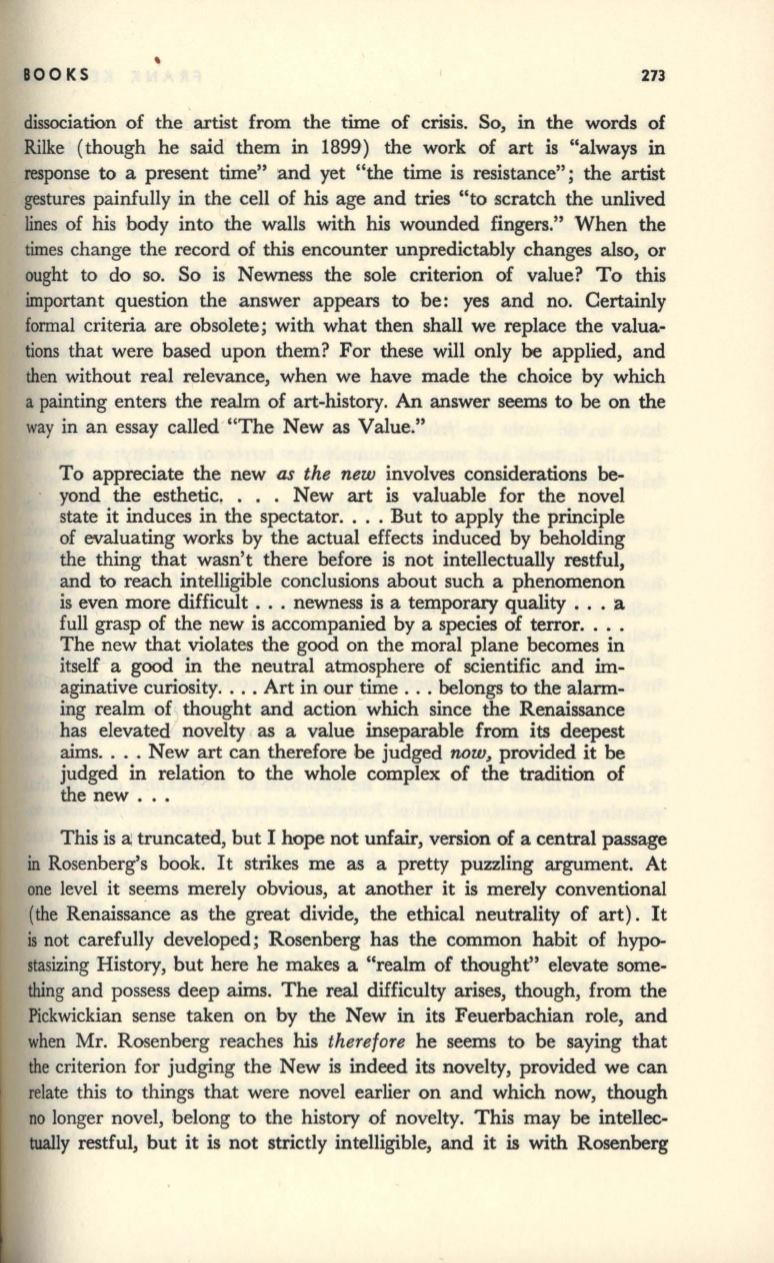
BOOKS
273
dissociation of the artist from the time of
CnslS.
So, in the words of
Rilke (though he said them in 1899) the work of art is "always in
response to a present time" and yet "the time is resistance"; the artist
gestures painfully in the cell of his age and tries "to scratch the unlived
lines of his body into the walls with his wounded fingers." When the
times change the record of this encounter unpredictably changes also, or
ought to do so. So is Newness the sole criterion of value? To this
important question the answer appears to be: yes and no. Certainly
fonnal criteria are obsolete; with what then shall we replace the valua–
tions that were based upon them? For these will only be applied, and
then without real relevance, when we have made the choice by which
a painting enters the realm of art-history.
An
answer seems to be on the
way in an essay called "The New as Value."
To appreciate the new
as the new
involves considerations be–
yond the esthetic. . . . New
art
is valuable for the novel
state it induces in the spectator.... But to apply the principle
of evaluating works by the actual effects induced by beholding
the thing that wasn't there before is not intellectually restful,
and to reach intelligible conclusions about such a phenomenon
is even more difficult ... newness is a temporary quality . . . a
full grasp of the new is accompanied by a species of terror....
The new that violates the good on the moral plane becomes in
itself a good in the neutral atmosphere of scientific and im–
aginative curiosity.... Art in our time ... belongs to the alarm–
ing realm of thought and action which since the Renaissance
has elevated novelty as a value insepara:ble from its deepest
aims.... New art can therefore be judged
now,
provided it be
judged in relation to the whole complex of the tradition of
the new ...
This is
a;
truncated, but I hope not unfair, version of a central passage
in
Rosenberg's book.
It
strikes me as a pretty puzzling argument. At
one level it seems merely obvious, at another it is merely conventional
(the Renaissance as the great divide, the ethical neutrality of art). It
is
not carefully developed; Rosenberg has the common habit of hypo–
stasizing History, but here he makes a "realm of thought" elevate some–
thing and possess deep
aims.
The real difficulty arises, though, from the
Pickwickian sense taken on by the New in its Feuerbachian role, and
when Mr. Rosenberg reaches his
therefore
he seems to be saying that
the criterion for judging the New is indeed its novelty, provided we can
relate this to things that were novel earlier on and which now, though
no longer novel, belong to the history of novelty. This may be intellec–
tually restful, but it is not strictly intelligible, and it is with Rosenberg


